Mode d’emploi DeWalt DCG416VSB Meuleuse angulaire
Besoin d'un mode d’emploi pour votre DeWalt DCG416VSB Meuleuse angulaire ? Ci-dessous, vous pouvez consulter et télécharger gratuitement le mode d’emploi PDF en français. Ce produit a actuellement 4 questions fréquemment posées, 0 commentaires et 0 votes. Si ce n'est pas le mode d’emploi que vous souhaitez, veuillez nous contacter.
Votre produit est défectueux et le mode d’emploi n’offre aucune solution ? Rendez-vous à un Repair Café pour obtenir des services de réparation gratuits.
Mode d’emploi
Loading…

Loading…
Évaluation
Dites-nous ce que vous pensez du DeWalt DCG416VSB Meuleuse angulaire en laissant une note de produit. Vous voulez partager vos expériences avec ce produit ou poser une question ? Veuillez laisser un commentaire au bas de la page.En savoir plus sur ce mode d’emploi
Nous comprenons qu’il est agréable d’avoir un mode d’emploi papier pour vos DeWalt DCG416VSB Meuleuse angulaire. Vous pouvez toujours télécharger le mode d’emploi depuis notre site Web et l’imprimer vous-même. Si vous souhaitez disposer d’un mode d’emploi original, nous vous recommandons de contacter DeWalt. Ils pourront peut-être fournir un mode d’emploi original. Recherchez-vous le mode d’emploi de votre DeWalt DCG416VSB Meuleuse angulaire dans une autre langue ? Choisissez votre langue préférée sur notre page d’accueil et recherchez le numéro de modèle pour voir si nous l’avons disponible.
Caractéristiques
| Marque | DeWalt |
| Modèle | DCG416VSB |
| Catégorie | Meuleuses angulaires |
| Type de fichier | |
| Taille du fichier | 7.53 MB |
Tous les modes d’emploi pour DeWalt Meuleuses angulaires
Plus de modes d’emploi de Meuleuses angulaires
Foire aux questions sur DeWalt DCG416VSB Meuleuse angulaire
Notre équipe d’assistance recherche des informations utiles sur les produits et des réponses aux questions fréquemment posées. Si vous trouvez une inexactitude dans notre foire aux questions, veuillez nous le faire savoir en utilisant notre formulaire de contact.
Sur quels matériaux puis-je utiliser ma meuleuse d'angle ? Vérifié
Les meuleuses d'angle sont mieux adaptés pour une utilisation sur le métal ou la pierre. Les machines génèrent beaucoup de chaleur et sont donc moins adaptées pour une utilisation sur du bois ou du plastique.
Cela a été utile (63) En savoir plusDois-je porter une protection auditive lorsque j'utilise une meuleuse d'angle ? Vérifié
Oui, vous devriez. Bien que la quantité de bruit produite par une meuleuse d'angle varie selon les marques et les modèles, une exposition prolongée aux bruits forts peut entraîner des lésions auditives permanentes. C'est pourquoi il est judicieux de porter une protection auditive.
Cela a été utile (16) En savoir plusDois-je porter une protection pour les yeux lorsque j'utilise une meuleuse d'angle ? Vérifié
Oui. De petites particules peuvent s'envoler lors du broyage. Lorsque celles-ci touchent l'œil, elles peuvent causer des dommages permanents aux yeux. C'est pourquoi il est toujours nécessaire de porter une protection oculaire.
Cela a été utile (14) En savoir plusPuis-je ranger des outils électriques dans un hangar ou un garage ? Vérifié
En général, vous pouvez ranger les outils électriques dans un cabanon ou un garage, même s'il y gèle parfois. Cependant, pour préserver la durée de vie de l'outil électrique, il est préférable de le stocker dans un endroit sec et sans variations de température importantes. Dans une remise ou un garage, les différences de température peuvent provoquer la formation de condensation, ce qui peut provoquer de la rouille. De plus, les outils fonctionnant sur piles durent moins longtemps et se chargent moins bien à des températures très basses. Pour être sûr de la manière dont votre outil électrique doit être stocké, lisez toujours attentivement le manuel d'utilisation.
Cela a été utile (6) En savoir plus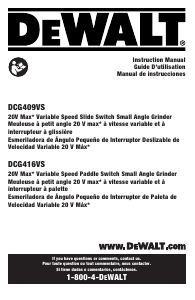


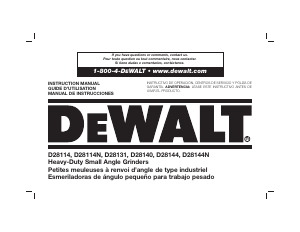
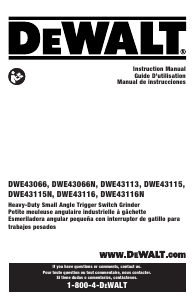
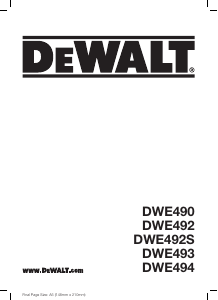
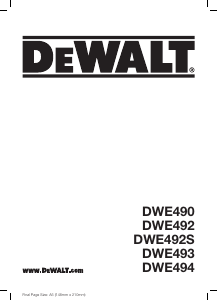
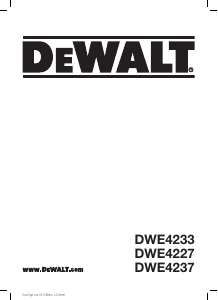
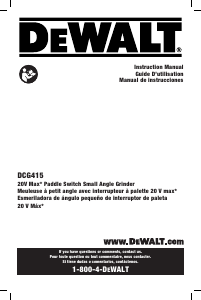
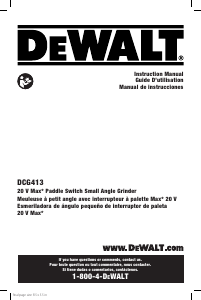
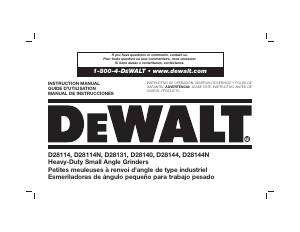
Joignez-vous à la conversation sur ce produit
Ici, vous pouvez partager ce que vous pensez du DeWalt DCG416VSB Meuleuse angulaire. Si vous avez une question, lisez d’abord attentivement le mode d’emploi. La demande d’un mode d’emploi peut être effectuée en utilisant notre formulaire de contact.